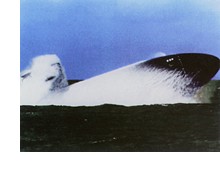|
Naval Air Warfare Center
|
By melding precision sand casting with stereolithography, the Naval Air Warfare Center
Aircraft Division, Indianapolis (NAWC Indy), achieves the perfect balance of speed, accuracy
and limited parts production for the U.S. Navy.
"SL patterns work so well with the precision sand casting method that the
approach has become standard operating procedure. We're now improving efficiencies,
accuracy of parts, and lowering costs even further."
- Todd Stahlhut, Mechanical Engineer
NAWC Indianapolis
|

|
The Challenge
When a naval program must be developed or upgraded, time is often the critical factor. System
delivery quantities are often low, and delivery schedules must correspond to an aircraft
carrier's arrival at port for its scheduled maintenance. Project engineers frequently come to
Todd Stahlhut and Kurt Anliker, mechanical engineers in the stereolithography (SL) service bureau,
sometimes in need of only 5-10 systems to perform a specific task. Critical parts from mounting
brackets to avionics chassis cases command immediate attention.
Recently, the "hot project" was development of 90 metal castings of a submarine distress
transmitter. They had only three weeks -- not months -- to reach first article to ensure the
design met the precision tolerance level necessary.
Calculated risk takers, Stahlhut and Anliker decided to try something for the first time:
using SL to produce the pattern for a limited production run in precision sand casting. While
adept at producing SL parts for prototyping and fit-checking, as well as for production of small
quantities of precision sand castings, higher volume production would be a first. They were
uncertain if the SL pattern would withstand the rigors of casting 90-100 parts, but decided to
take the gamble to meet this critical deadline.
The Results
Working closely with a foundry highly skilled at converting SL patterns into molds for investment
casting and precision sand casting, NAWC Indy met its time and cost schedule by a wide margin.
The benefits of SL in the precision sand casting mode promise to redefine how NAWC Indy handles
its "hot projects":
- From CAD file to first article delivery, inspection and approval in weeks, not months
- From procurement award to final unit delivery in only four months
- Traditional tooling would have run $20,000; risk was minimized by proving out the design
before any upfront investment
- NAWC Indy spent only $5,000 via SL/ precision sand casting, yielding a perfect casting
- Design engineers are now able to accomplish project goals once thought unattainable within
shrinking budgets and fast-paced time cycles
The Process
NAWC Indy first built a half-scale model on their SLA 250 to prove out the design. Because the
full-scale part exceeded build dimensions of their SLA, engineers outsourced the final pattern to
a service bureau with an SLA 500. Both the Pro/ENGINEER file and .STL part file were sent on 1/4"
tape to Solidiform, the casting foundry, with shrink factors incorporated. The file was exactly to
Solidiform's requirements -- clean, closure on all entities of the solid, and properly defined
features, enabling Solidiform to obtain SL production patterns from a neighboring service bureau.
Once gating and rigging were verified, the casting was built in two halves: the "cope" top half
and the "drag" bottom half. Fine grain sand was lightly packed around the SL pattern. Chemical
agents were used to bind the sand for a rock-like setup in only 6-8 minutes, creating the core and
cavity. Metal was poured into the mold, allowed to solidify, and sand surrounding the metal part
removed. One hundred castings were yielded from the same SL pattern, ensuring that 90 were
delivered in 30-piece increments.
Precision sand casting seeks to emulate investment casting. When selecting a process, a trade-off
is made between time, dimensional tolerances, surface finish and cost, depending on part quantity
required. Precision sand casting cannot achieve the high quality surface detail delivered by
QuickCast. Time, however is its advantage. From receipt of the SL pattern, precision sand casting
can be accomplished in one week compared to two weeks via QuickCast. For certain users, precision
sand casting offers the right balance between time and accuracy, and yields a reusable pattern for
limited runs.
The Tools
- Pro/ENGINEER version 12 3-D solid modeling software
- SLA 250 with Cibatool SL 5170 resin
- SLA 500 with Cibatool SL 5180 resin
Company Profile
The mission of the Naval Air Warfare Center Indianapolis is to conduct research, development,
engineering, material acquisition, pilot and limited manufacturing, technical evaluation, depot
maintenance and integrated logistics support on assigned airborne electronics (avionics), missile,
space borne, undersea and surface weapon systems, and related equipment.
In support of this mission, NAWC Indy has operated its own SLA 250 since 1990, and generates
about 200 different part configurations yearly.
|



